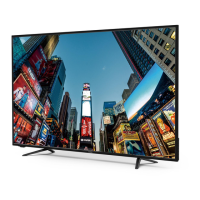
Do you have a question about the RCA RTU4300-E and is the answer not in the manual?
| Screen Size | 43 inches |
|---|---|
| Display Technology | LED |
| Refresh Rate | 60 Hz |
| Smart TV | Yes |
| HDMI Ports | 3 |
| USB Ports | 1 |
| Wi-Fi | Yes |
| Operating System | Roku TV |
| Ethernet | Yes |
| Bluetooth | No |
| Resolution | 1920 x 1080 (1080p) |
| Built-in Apps | Netflix, YouTube |
Read, keep, heed instructions, ensure proper ventilation and avoid blocking openings.
Avoid water/moisture, heat sources; use dry cloth for cleaning; protect power cord; ensure proper grounding.
Refer all servicing to qualified personnel; keep the unit in a well-ventilated environment.
Explanation of CAUTION, RISK OF ELECTRIC SHOCK symbols; appliance is Class II double insulated.
Lists remote control, AAA batteries (x2), warranty card, instruction manual, and base stand with screws.
Instructions on aiming the remote control at the sensor and its effective operating distance.
Step-by-step guide on opening the battery compartment and inserting two AAA batteries.
Advice on replacing weak batteries, avoiding leakage, and not mixing battery types (alkaline, carbon-zinc, rechargeable).
Safety guidelines for TV installation and use, child safety, and wall mounting precautions.
Detailed description of each button on the remote control and its corresponding function.
Identification of front panel components: Color Screen, Standby Indicator, Remote Sensor, and Speakers.
Listing and description of all input/output ports located on the back of the TV.
Instructions on how to turn the TV unit on and place it in standby (OFF) mode.
Guidance on signal sources for viewing TV channels, including antenna, cable, and satellite systems.
Instructions for connecting external audio/video devices such as VCRs, camcorders, or satellite systems.
Details on connecting devices with a composite (Yellow RCA-type) video output.
How to connect High-Definition devices using component video and audio cables.
Steps for connecting High-Definition devices using a single HDMI cable for video and audio.
Description of how to connect the RCA audio output for sound.
Instructions and precautions for safely connecting the TV's power cord to the outlet.
Guidance on connecting the TV to a home theater system for enhanced audio performance.
Instructions on how to configure the digital audio output settings for optimal sound.
Step-by-step instructions for attaching or detaching the TV's base stand.
Information on VESA compliance and requirements for securely mounting the TV on a wall.
Guidance on selecting a stable and safe location for the TV, avoiding heat and moisture.
Instructions on how to use the remote control to select the desired input source (TV, HDMI, AV, etc.).
How to select between AIR and CABLE modes for signal input based on connection type.
Procedure for performing an automatic scan to find and store available TV channels.
Detailed options within the Picture menu for adjusting contrast, brightness, color, sharpness, and color temperature.
Options within the Audio menu for sound enhancements like sound modes, equalizer, balance, and surround.
Configuration of local time zone, daylight saving time, and automatic clock adjustment.
General setup preferences including language, menu display, closed captions, and factory reset.
Instructions for blocking TV content using passwords and setting parental controls.
Explanation of US TV rating system (G, PG, PG-13, R, NC-17, X) for content filtering.
Explanation of Canadian TV rating system (C, C8+, G, PG, 14+, 18+) for content filtering.
Options for channel setup, including auto scan, favorites, channel labeling, and signal strength display.
How to access and play media files (photo, music, text) from a connected USB storage device.
Detailed guide on viewing photos from a USB drive, including navigation, zoom, and slideshow options.
Instructions for playing music files from a USB drive, including playback controls and repeat modes.
Guidance on reading text files (*.txt) from a USB drive, including navigation and information display.
List of resolutions, scanning frequencies, and formats supported via Component and HDMI connections.
Information on panel type, screen size, resolution, brightness, contrast, viewing angle, and system settings.
Details on various input/output ports, audio system, and power requirements.
Troubleshooting steps for picture problems, no sound, color issues, panel malfunctions, and display anomalies.
Information on the one-year warranty period, exclusions, and claim process.